This site is being reconstructed from an archive. Please be patient while we revive our demonstration project. Not all of the links will work. Some resources have been removed or relocated from the original location. Bitly links are no longer active.
The new era…
So, now what do we do? We have conducted research using family documents and public records; we have collaborated with family, relatives and other people online. Some people are happy just to have documented their lineage. Others like to include stories and some include pictures of the people or places they are writing about.
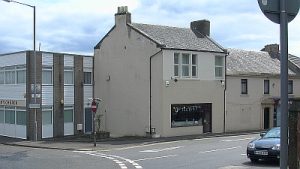
The old house and store on Chapelwell in Saltcoats, Ayreshire, Scotland
The way that is happening is changing. Now days, we see blogs, such as this one, educating newcomers and publishing stories or family histories. They include photos, whether scanned or digital born, and are integrated into these blogs to illustrate the stories as shown with the example of our great grandmother’s childhood home in Saltcoats, Scotland.
Other examples include the use of Flickr’s interactive slide shows. The Ancestry Tour is a good example.
While it has been an interest among many genealogists and family historians to travel to the places where their ancestors lived there is a new trend emerging for people with an interest in genealogy and family history. The travel industry and genealogical researchers have teamed up to offer travel, research and meet/stay with your relatives (whom you have never met) travel packages. While we have seen these services advertised in the United Kingdom, we have not heard whether or not they are having success. As for us, we chose a simpler option. We knew the names and locations of our ancestors and simply chose to walk where they lived. You can view our YouTube video series titled “Walking Where They Lived” by using the link below.
Walking Where They Lived: Saltcoats
Genealogy is being taken up by the online generation and the trend is social oriented with Facebook pages, Twitter feeds and Pinterest Boards just to name a few. Whether you’re a professional genealogist, or an enthusiast looking to tell your family’s story, we hope this project has successfully demonstrated some of the applications of social media in the genealogy arena.
The Letters
The allied families referred to in our previous post consist of descendants from the seven sons (William, James, Joseph, Wilson, George, John and Elam) of John S. Britton and Mary Russell. John and Mary are the common ancestors that tie these families together. For decades family researchers have been “brick walled” when attempting to move

A brief sampling of “brick walled” family trees with Joseph Britton. Accessed via free search – Public Member Trees at Ancestry.com
beyond the John and Mary entry. Part of the problem was not knowing the names of John’s parents. Once the names became known, a challenge still existed. Indiana did not begin to officially record vital statistics information until 1882. As a result, a public record of Joseph’s death or place of burial has not been found. It is only from allied researchers sharing information from family records that we learned he was interred on the family farm in Indiana.
Progress beyond Joseph and Mary has been seen in some of the public member trees published at Ancestry.com in the last few years. A careful study of the sources used in these trees indicates most originate from a common source outside the realm of public records. Douglas Jones maintains a family website which includes a genealogy section (Jones Genealogy Site). He has scanned and posted some letters from the early 1800s that may apply to the allied Brittain/Britton families. Investigation is definitely warranted.
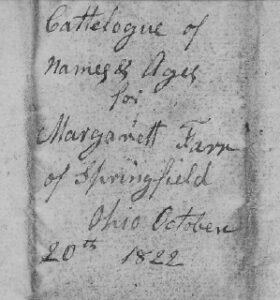
Enhanced excerpt from scanned letter. Joseph Britton to Margaret Farr. Used with permission.
The three letters were written by Joseph Britton. One letter, which is of particular interest to us and perhaps others, is addressed to Joseph’s daughter Margaret. In 1822 Joseph detailed the family lineage. In the “Catalogue of Names and Ages” written for Margaret Farr of Springfield, Ohio, dated October 20th 1822, he writes that his “grandfather was an Englishman and was born there”. Is Joseph’s grandfather the immigrant in our family line? The letter is detailed with the names, birth dates, marriage, and re-marriage accounts including the spouse names and locations.
As we have mentioned before there has, for many years, been rumor and speculation about ancestors in Tennessee. Joseph mentions the Britton families in Tennessee and the area where they were born and lived. Could this be the missing link so many have been looking for?
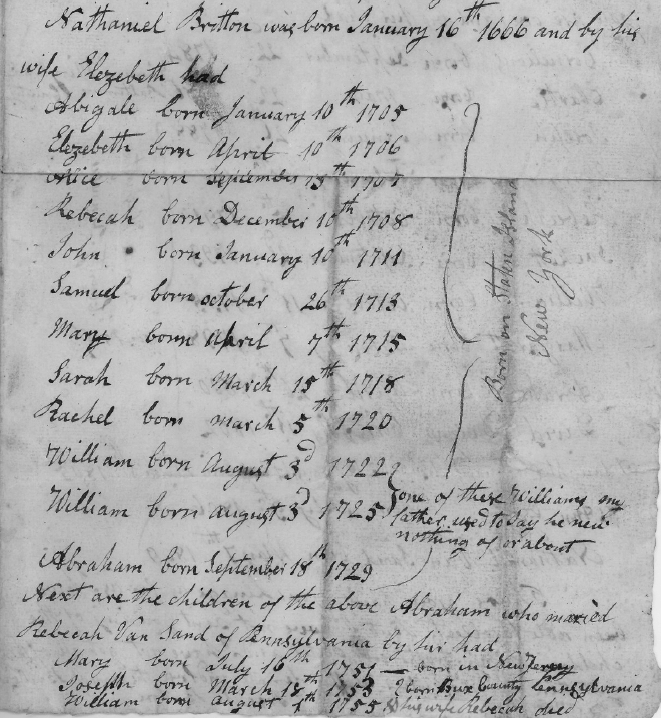
A portion of the letter from Joseph Britton to Margaret Farr shows the names, dates and location of births. Used with permission.
We decided to chart the information starting with John Britton from our family information to see how it would connect.
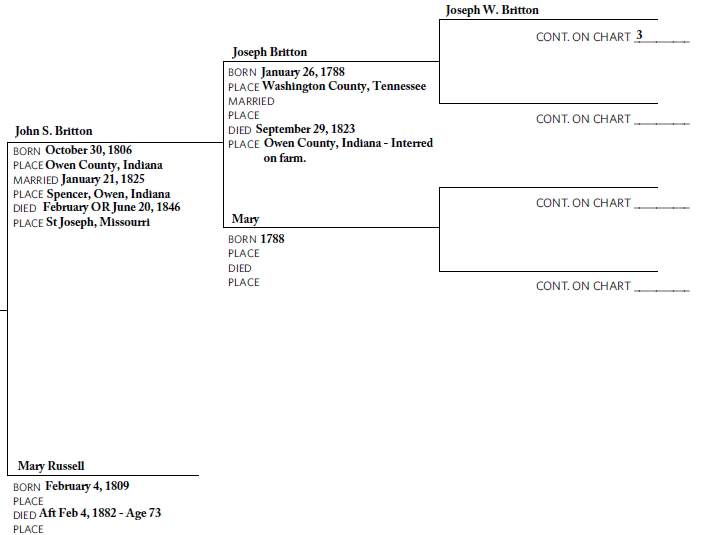
Chart 1 – Extended lineage from John S. Britton to Joseph W. Britton based on Joseph Britton’s letter to his daughter.

We have confirmed the information for John and Joseph Britton in Chart 1. We verified Joseph’s presence in Indiana using the 1920 US Federal Census. Speculating that this is the Joseph Britton in the letter (Margaret’s older brother) we can complete the trace back to England as seen in Charts 1 and 2 above. We have compared our information to family trees online at Ancestry.com. While there are family trees completing the trace back to England, it is noted in some records that the information is unsourced or only obtained (copied without verification) from other trees. A few family trees have extensive documentation for their records. As one very thorough researcher associated with this family line has suggested in her profile comments, one should double check everything.
Current Status: Enough information is presented to warrant continued work. We are taking the advice previously mentioned and verifying the accuracy of what we have found. It is looking good. However, complete verification will take time.
Full charts can be accessed by visiting The Five Lines page on our blog menu. The Brittain Charts can be accessed directly using the links below.
Brittain Chart 1 Brittain Chart 2 Brittain Chart 3 Brittain Chart 4
Note: A very special thank you to Douglas Jones for scanning and posting the Joseph Britton letters and giving us permission to use them in this post.
The Brick Wall Tumbled
It’s a fact that documents and records do get destroyed in fires, floods and other disasters, as well as deteriorating beyond use or recognition over time. We have had the devastating reply in response to an inquiry that the records we were seeking were destroyed when the Court House burned in the mid 1800s. Also, vital statistics may not have been recorded by local, county or state entities prior to a certain time period. Or, they may not be digitized and can only be accessed by a visit to the physical location of the only book with the recorded information. Even more unfortunate is when documentation (family records) is just tossed out because the person having to make that decision does not see any value to the documents. But, one does have to believe somewhere, the information does exist.
There are different ways to document family information in the absence of public records. For many the family Bible was used as the official family record. Some Bibles had pages included to record births, deaths and marriages. Others merely had pieces of paper stuck inside the cover or between pages. Other documentation may have included hand written letters or personal recollections as we experienced with the Stuart family line.
Moving farther back in time from the great, great grandparents took an eternity, or so it seemed. John’s parents were unknown. Progress moved one more level when a query was posted online that included the name of John’s father and mother. Joseph Britton (John’s father) is believed to have been interred on the family farm in Indiana. We did find Joseph in the 1820 US Federal Census verifying his residency in Owen County, Indiana. Work on this family line was off and on for more than a decade with little to no progress.
In 2008, a few documents began appearing in family trees on Ancestry.com. Could it be the brick wall was about to tumble down for the allied families looking to move beyond Joseph and Mary Britton? Rumors and speculation had existed for many years about a connection to one of the Britton families in Tennessee. However, there was nothing to serve as documentation for verification until a family in Oregon scanned some old letters and made them available online.
In our next post… The Letters
Public Records & the Name Game
Now that we have successfully traced the Stuart family line it’s time to move on. Tracing the Brittain family line was a different experience. The recent ancestors, father and grandfather, were known by living relatives so verification of information was relatively easy. Great grandfather, Elam Brittain, is well documented in public records as are the father and grandfather. For example, Elam can be found in the US Federal Census for the years 1850 – 1920.
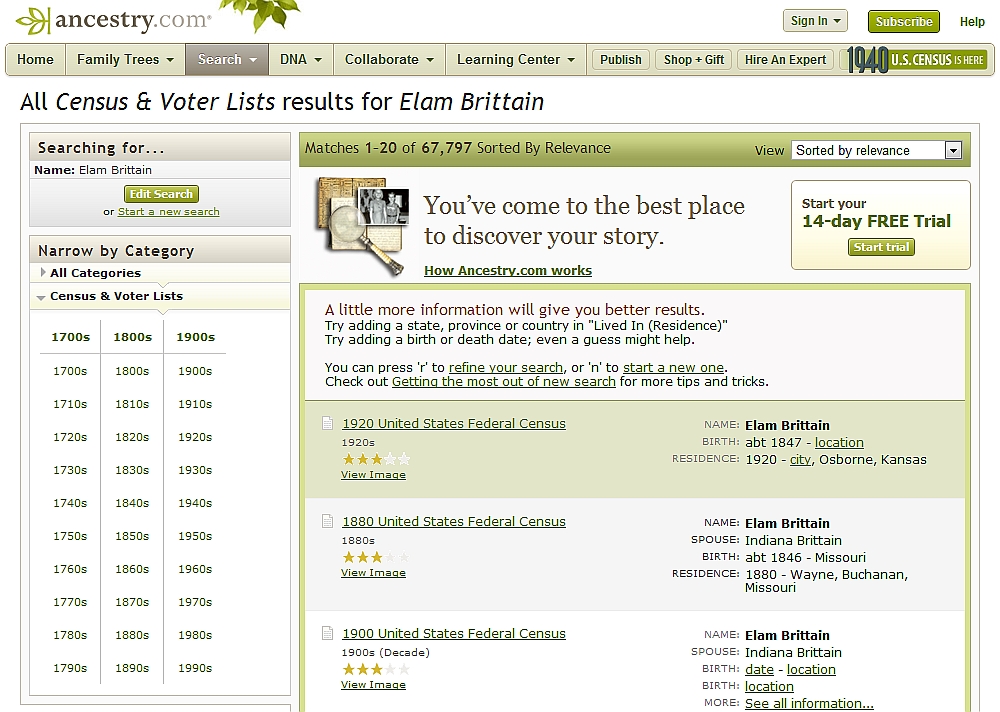
Census records for Elam Brittain found using the free search at Ancestry.com.
Name Variations
In our last post we mentioned the need to consider variations in the way names are spelled. This video tutorial explains why spelling variations need to be considered as well as why changes in spelling may have occurred.
You can also find this video on Our YouTube page.
Completing the trace… Stuart Chart 9
After experiencing a successful collaboration with the US and Kansas GenWeb Projects we were able to complete our trace of the Stuart family line for the ancestor names we had to work with. The information provided by our contact in Kansas clarified names, dates and locations. At the same time, it also raised questions. For example, much of the information found in family records and online indicates Margaret Stuart was born in Scotland. However, as seen in our previous post, the 1851 Scotland Census reveals she was born in Ireland and lived in Scotland as a young child. One will have to decide which to accept for their documentation. We have chosen to accept the official recorded entries in the public records.
Surname spellings present a unique set of challenges. Not only have we found different spelling in public records, ranging from accepted known variations to complete misspelling of the name, we have also seen the Stuart and Stewart spelling used within the same family (see ourJuly 2, 2012 post). We have used the Stuart spelling as it is the most prevalent in both family and public records. One needs to be aware of the spelling variations and consider other details about the person to avoid being led a stray in their research. To see an example, take a look at the chart comparison below starting with Margaret Stewart from an online profile and compare it to Margaret Stuart from our chart. Keeping in mind the accepted variation in name spelling, we can compare the details for each ancestor and determine they are the same.
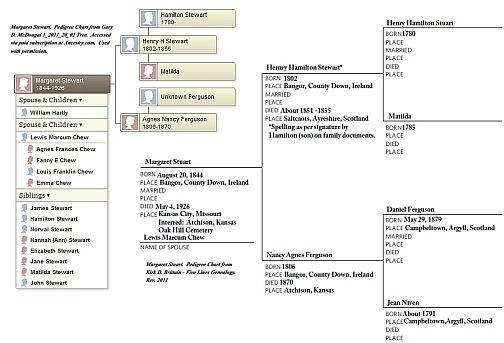
Pedigree chart comparison. Margaret Stewart Pedigree by Gary D. McDougal. Used with permission. Margaret Stuart Pedigree by Kirk D. Brittain – Five Lines Genealogy.
Also, we know it’s the same family because our grandmother is listed as one of Margaret Stewart’s children from her second marriage. This may very well be a descendant of Margaret’s older brother who came to America several years after Nancy and her daughters or perhaps another sibling. We know, as previously discussed, Hamilton used the Stewart spelling of the name. As to why there is a different spelling of the surname within the immediate family, we do not know. We do know we’ll see the scenario again with the other family surname being featured in this blog. Given names can be confusing as well. Margaret’s mother, Nancy Agnes (Ferguson) Stuart is often times found as Agnes Nancy (Ferguson) Stuart or Stewart as seen above.
Continuing the trace… Whoa! A brick wall!
On occasion, it seems as though information to the next step in the chart just simply does not exist. This is the brick wall moment. No one in the immediate family knows. It appears as though there are no public records for the person. What is one to do in this situation? This is where a person has to be creative and resourceful. Sometimes the “brick wall” really does exist. Other times, it is a road block instead of a brick wall. The direct path may not be available but, alternative routes can lead to the same place.
The Margaret Stuart detour is an example. All that was known is that she was from Scotland. Part of the problem was misinterpretation of verbal history. Initially, the birth place was believed to be Del Rye, Scotland. All searches for information failed. We now know Del Rye, Scotland is Dalry, Scotland. Regional dialect and pronunciation can have a misleading impact when recording verbal information. However, Dalry, Scotland is still incorrect for the place of birth.
Collaboration provided an alternative means to the needed information. By posting a query on the Kansas Board of the US GenWeb Project (now The Kansas GenWeb Project) I was contacted by an individual who told me we were researching the same family line. We exchanged a few e-mails to make sure we were talking about the same person, and
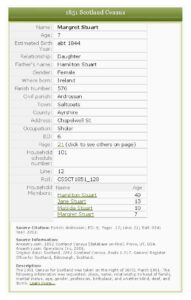
Record for Margaret Stuart from the 1851 Scotland Census. Matilda is also listed. Accessed via paid subscription at Ancestry.com.
we were. It turns out the individual is a descendant of Matilda Stuart, Margaret’s older sister. He was more than happy to share the information he had. Documentation included a copy of a hand written account of the family lineage (written by Matilda) and a copy of the promissory note signed by Nancy Stuart, Great, Great Grandmother and her son, Hamilton Stewart (notice the different surname spelling by mother and son). The note was signed at the Dalry Branch of the Perpetual Immigrating Fund Company, Organized at Great Salt Lake City, Deseret, USA October 6th, 1849.
The information provided by the sibling’s descendant cleared the road block and allowed us to complete the trace for our Great Grandmother, Margaret Stuart. Public records reveal Margaret lived in Saltcoats, Scotland and was born in Ireland.
Collaborative Genealogy websites, such as The US GenWeb Project and state affiliates, is one workaround that may be viable when it seems like there is a brick wall in front of you. We were fortunate to find the descendant of a sibling. There are other options which we’ll discuss in future posts.
A completed pedigree chart
This pedigree chart has been completed with advice from previous posts in mind. Brittain Chart 1 starts with a “Living Brittain” and details the parents, grandparents and on back. For the purpose of discussion, we’re focusing on the great grandparents, Elam Brittain and Margaret Stuart. Lewis Chew is a secondary focus and part of what we’ll be illustrating in upcoming posts. The great grandparents were chosen because for many years, there was a roadblock or “the brick wall’ as some call it, related to these individuals.
Following the blue highlight, we find Elam W. Brittain on Chart 1. Under Elam’s name we see his details are on Chart 2 (Brittain Chart 2). This is indicated by the number 2, highlighted in red. At the grandparent level, we see highlight colors change as the ancestral names change. The green highlight provides the path on the grandmother side back to Margaret Stuart. Margaret’s details are also continued on another chart (Stuart Chart 9).
As you can see, the pedigree (ancestral) chart provides a good visual representation of one’s ancestors with an easy reference to continued information.
Note: Names are highlighted for discussion purposes only.
Social media and online safety
An insightful webinar by Legacy Family Tree Webinars. The recording is free to view until July 2, 2012. It discusses various social media and privacy concerns as well as online safety in general. The genealogists in this webinar explain the use of social media for genealogy. Many of the tips and resources mentioned will be beneficial for all users of social media. View the recording while it is free.
http://www.millenniacorp.com/_videos/webinars/2012-06-22-safe/2012-06-22-safe.html
This is a long link and may break. You can also use the shortened link below.

